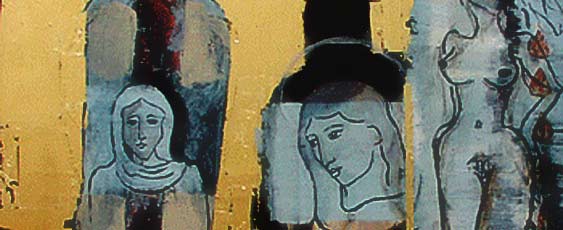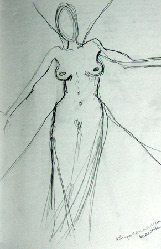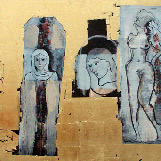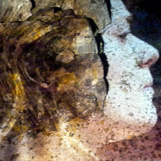
A Woman's Place
Artist Alex Hoare has spent the year working on a site-specific installation and performance project inspired by the remains of Nunnaminster,
an old nunnery in Winchester, Hampshire.
Throughout the year she has developed her own paintings, video and sound working collaboratively with a
filmmaker and performers (all female) to use this space to explore concepts that might link us as women in the twenty-first century to the women
who may have inhabited the space 1,000 years ago.
Below is an account of some of that process, culminating in a final installation/exhibition in Winchester in Spring 2006.
February 2005 starts with the news that I have received the Arts Council funding I had applied for before Christmas. The first part of the project is already underway. I spent some of January in the freezing cold, stark naked, clambering over old stones and tombs in an 'exploration of the naked female form in a landscape of past lives!'
Myself and my filmmaker, Lou Pack, had established from a website (whether it was reputable or not I have no idea!) that as long as you didn't have a penis you could not be charged with a public order offence - an interesting political comment in itself. The resulting footage shows amongst the more useable stuff a somewhat nervous figure lying in a stone sarcophagus with a cream wrap to hand in case of passers by.
I should explain that the core concepts of my work, which involves painting, video and performance, are centred on the desire to create images of a female body which reclaim female nakedness from the slick, sexually aggressive images which we are bombarded with by the media. In doing this I also try to layer subjectivity and identity onto the 'object' of the female body in art, without being aggressively feminist or blatant, but rather through subtle interaction of images and sound and space to quietly place a 'womanist' agenda in the heart of what I do.
My intention in prancing around naked in the site of an abandoned archaeological dig was to explore the tensions between the naked female form and a former consecrated site that was lived on by a group of Christian women vowed to god.
For this project I chose to work with women only. The project is inspired by the fact that for 500 years the site we were exploring was inhabited by a community of women. My interest was in those women's lives, the systems they lived within, the tasks they undertook; to me it seemed that they lived within strict time-frames for everyday life, but that many tasks such as illumination and embroidery (for which these particular Winchester nuns were renowned) were also quiet and reflective. I wondered what they thought as they sat and stitched, I wonder if many of us have that time to reflect today.
Because of the subject matter of my work, being a woman artist is particularly relevant. I can only work with concepts that are important to me and that I have a passionate desire to communicate to others. These often involve my thoughts and feelings about my position as a woman in contemporary society, my body as one site of my identity and increasingly my relationship to women of the past. There is no doubt that being a mother also has a profound effect on the way I work; gone is the luxury of absorbing yourself in a project for months on end, reality intrudes with regularity that forces you to rethink and incorporate this into the way you work.
The first stage of A Woman's Place was an exhibition/installation in the Atrium Gallery at the Theatre Royal in Winchester. This ran through February 2005. The build-up to this involved not only the aforementioned exposure to the January elements in the ruins, but also extensive research into any information I could find on the lives of the women that would have lived in the nunnery. My reading served to contradict most of my preconceptions about nuns.
My vision of a place full of devout women, bound by strict vows, was shattered, but what evolved was actually far more interesting in relation to my own work. I discovered that these women were mainly from more affluent families, often placed in the nunnery by parents wanting to keep them away from the clasps of men before they were ready for marriage; that often they came out of the nunnery when a suitable marriage had been arranged; that widows with children often entered after the death of their husband; that each nun would have a different level of vows, some more devout than others.
It was not a community of pure, devout virgins, but rather a community of women away from the demands of endless childbearing that the patriarchal society placed on them - in some ways a safe haven - but with everyday concerns.
The archaeologist at the local city council who had been involved in the dig in 1983 which had uncovered the remains provided me not only with a great insight into the Nunnaminster itself but also some fascinating images from medieval times and photographs and relics from the dig.
I was particularly interested in visual imagery associated with the interior of the abbey, of which there is little. Perhaps because I am a women artist and a scenographer I approached the site through the women, and I found myself particularly intrigued by imagining the environment that they may have lived in. Relics from that time suggest brightly coloured embroideries, tiles and stained glass. My imagination depicts an earthenware-tiled space, clear and clean. My Medieval Costume of England and France shows the type of clothes they might have worn.
I was particularly drawn to the faces of women depicted in iconic paintings of the time, women's faces calm and contemplative symbolising the mother of God, and how these faces were used as an image for reflection, prayer and devotion. Feminine figures, extremely beautiful... and I began to create my own to explore how this felt in a contemporary context. As a vaguely spiritual, rather than religious, person I was interested in the association placed upon images such as these, and their status as icons.
On 1st February I hung four blank black canvases on the walls of the Atrium Gallery. For two or more days each week I took each canvas off the wall and worked on them in public, drawing on the work I had done previously. I would have to hang them back up at whatever stage they were when I had to leave, often when I had to go off to do the school run. This process caused much discussion. For myself as an artist, it raised many questions about at what point it is appropriate to release a work to the public.
Developing a piece of work, which is essentially a very private thing, in public makes you feel very vulnerable. The evolution of a painting involves many mistakes and re-workings, and usually this is done in the privacy of a studio. To put these failures into the public domain opens you up to another level of criticism and made me wonder why people feel it necessary to be so judgemental. There are parallels here with using your own naked body for your work, warts and all - or in this case having born and fed two children: risk, honesty and representation of things as they are.
The month culminated with a 'closing' where all the paintings were exhibited along with a video montage of our work in the site and a soundscape of singing and poems I had started working on with my performers.
What I had learned through this painting stage of the project was now taken into the next stage of the project, the devising of a performance installation with a group of five women performers. Each performer was from a different decade of life, an 11-year-old, a 24-year-old, a 34-year-old, a 41-year-old and a 63-year-old. I asked them to respond to a number of things (which I have outlined below) from the perspective of the decade of life they were now in.
The Site
I wanted to explore two separate elements of the site in relation to performance, its physical terrain and its history. The performers needed to be aware of both the present appearance of the site and its various previous appearances. I showed the performers plans of the three buildings which had stood on the site, a series of chapels from the 10th century to the 14th century.
Small fragments of each of these buildings can be seen in the way the site has been laid out by the archaeologists. They have also used different coloured stones to depict different stages of the site. Red stones are the oldest building, flint the eleventh century incarnation and white stones for the background. Visually, this leaves the site divided into five sections, and for the performance I felt this would be a useful device to help structure the piece.
Time-frames
Something which had fascinated me was the parallel I had drawn between the strict time-frames the nuns would have had to keep and the time-scales we work within as mothers. The Benedictine rule which was brought in during the 12th century divided the day into eight canonical hours known as 'divine office'.
The normal day started at 2 am with Matins, followed successively by Lauds, Prime, Terce, Sext, None (noon), Vespers and ended with Compline about 7 pm. This information reminded me of the time schedules of my children which tend to rule my life. As babies, they require regular feeds every few hours. As they grow older, the schedules are not as extreme, but still revolve around a series of meals, activities, school days and bedtimes - these are my matins, lauds and primes...
The Costumes
I showed the group drawings of medieval costumes, not simply nun's habits, but the types of clothes that women generally would have worn. I then asked each of them to design their own costume to fit in with the concepts of the piece and their own particular response to that. This freedom to express through the clothes they would wear was greeted with great excitement and much thought, each trying to work their own preferred style of dress into a form that would have been vaguely relevant a thousand years ago.
The Sound and Text
Jo Blake, the performer in her twenties, is also a storyteller. I asked her to write the story of Nunnaminster especially for the performance. This was then recorded, edited and placed back into the site during the performance. It drew upon both the historical facts we knew and the concepts we were exploring. I used this in the editing process to emphasise the time rules we were thinking of.
In addition to this, Professor June Boyce-Tillman, the performer in her sixties, specialises in music, and particularly spiritual and healing music. We recorded her singing hymns in Latin at the site, and this created a very eerie and beautiful background for the layering of other sounds.
The other source I used for sound and text was some poems by Nicola Slee from the book Praying like a Woman. These poems, particularly Write the Body, (see my website, details in footnote) spoke to me of issues that I think are central to the piece for the appreciation and understanding of the multilayered lives we lead as women, and for this alternative, more complex image of womanhood to be acceptable in public as well as private.
On 30th June this year we presented a performance installation to an audience at the site, with five women performing, three projections and live and recorded sound.
The project is ongoing; I am still not totally sure, at the time of writing, what the final outcome in 2006 will be, but envisage some form of exhibition-performance-installation bringing all our work together. What I think I have learned is that the concerns that we as women have today are probably not much different to those of women a thousand years ago, but that we just live within a different set of rules.
Reflections:
- Cos I'm a Woman,
W-O-M-A-N
Miriam King
Dramaturgy in Action
Beccy Smith
Big Daddy versus
Mother Hen
Marigold Hughes
Through the Threshold
Carran Waterfield
A Woman's Place
Alex Hoare
The Mother
Dorothy Max Prior
Dances on Street Corners
Virginia Farman
Wollstonecraft Live!
Anna Birch
The Right Kit
Alex Mermikides
Going to Extremes
Dorothy Max Prior




